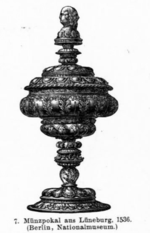Cup (drinking vessel)
A cup (of Italian boccale "bulbous drinking vessel", going back to ancient Greek βαύκαλις bá͞ukalis "wine or water cooling vessel") is a drinking vessel, the shell ( Kuppa ) is separated from the base by a separate shaft. Glass cups are called such when they stand out from the stemmed wine glass due to their size or precious processing. The tazza also has a foot and high shaft, but unlike the cup, it has a very flat cup. It differs from the chalice and ciborium in its profane use, and from the beaker in its high shaft. In the older, especially poetic language usage, however, cup and cup are still almost synonyms.
materials
Cups were mainly made of metal, primarily silver . Particularly valuable pieces were enriched with precious stones, pearls and enamel work in the 16th century . Today other shiny white alloys , silver-plated, anodized and galvanized materials are also used.
Pewter trophies are mainly handed down as a “ welcome ”. Larger wine glasses and representative showpieces made of ground and cut glass are also referred to as cups. This also includes the health glasses . Turned wooden goblets were more common in the 16th and 17th centuries than the few surviving examples suggest. There are also cups made of ivory , alabaster , serpentine , and exotic natural materials such as ostrich eggs, coconut and other nutshells, clams and snail shells, all of which were more art chamber pieces than they were actually used for drinking. Ceramic materials are rather unsuitable for this type of vessel due to the fragility of the shaft, so there are hardly any examples of this in the history of handicrafts.
Silver cups
The history of their shape and the significance they have in secular customs up to the present day are inconceivable without the prehistory of the sacred chalice in the Middle Ages. Profane trophies from the Middle Ages are rare. The few exceptions include a few English examples. The imperial cup in the Osnabrück town hall, on the other hand, was originally a sacred ciborium.
Around 1500, with the transition from the Middle Ages to the Renaissance, the first great silver trophies for princely art chambers and bourgeois council silver treasures were created in Germany. Initially, their shape is still determined by the hump, which is very much in keeping with the goldsmith's technique of driving . It gives the kuppa a detailed, still late Gothic appearance. In different versions, some of which are called "Columbine", "Pineapple" or "Grape Cup", the humpback cup lasted until the 17th century.
In the first half of the 16th century, a type of cup, divided horizontally by bulges and constrictions, developed. With the double cup (Fig.), Two cups with a similar shape can be placed on top of each other with the lip rims so that the upper one serves as a lid for the lower one. He is credited with a role in wedding customs. In the decades around 1600, smaller, simpler, but never completely ornamented goblets also have a slender, cup-shaped cup. In the 16th and 17th centuries, silver goblets often have figurative shafts unless the standard baluster or vase shape is chosen. If, following a tendency towards naturalism , the kuppa is occasionally formed in the shape of an apple, a pear or a melon, the stem is often branch-shaped.
In many goldsmiths' guilds, the production of a cup was one of the requirements for the masterpiece, so an Akeleipokal was prescribed in Nuremberg since 1531 (then also in other cities based on this model) . Cups were all provided with lids, even if these were lost more often than the vessels themselves.
Since the function of the cup as a representation gift and show piece always went beyond being a mere drinking vessel, it is decorated with gilding and elaborate ornamentation throughout. Since the late 17th century, hardly any new goblets have been added to the royal and urban silver treasures, faience , porcelain and cut glasses compete with the silver table decorations on the festive table. Only for the retrospective world of guilds were silver “welcome” cups made in the 18th century.
In the 19th century people remembered again, as Schinkel's designs show, the “dignified form” of the cup, and historicism in handicrafts carried on its cult with it wherever a victory or anniversary is to be celebrated. Mechanization in the silver goods industry made the silver, but above all the silver-plated, cup into a series item.
Exhibitions in Germany
Since there is hardly probably a cultural history, local history or the arts and crafts museum dedicated to that did not exhibit some of trophies is drawn to a few special collections: Unusually rich examples of silver goblets host the Green Vault in Dresden , the Treasury of the Munich Residence and the Museum of Decorative Arts Berlin .
- “Tribute cups” in the Residenz Museum in Celle Castle
literature
- Carl Hernmarck: The Art of the European Silversmiths. Munich 1978, p. 85 ff.
Web links
Individual evidence
- ↑ Cup. In: Digital dictionary of the German language . Retrieved November 13, 2019
- ↑ nzz.ch
- ↑ z. B. Propylaea: Art history . Volume 6. The high Middle Ages. 1972, No. 452 and LX.
- ↑ Edmund W. Braun: Agley cup . In: Real Lexicon on German Art History . Volume 1, 1933, Col. 206-212




